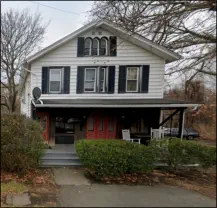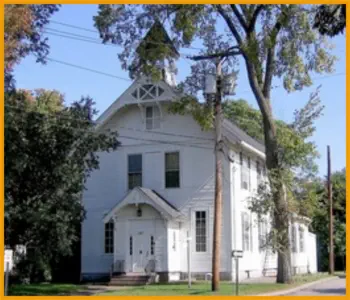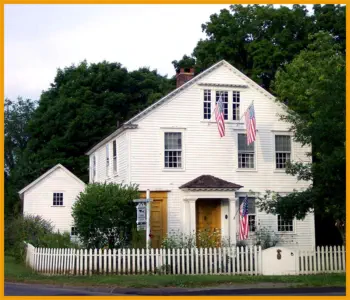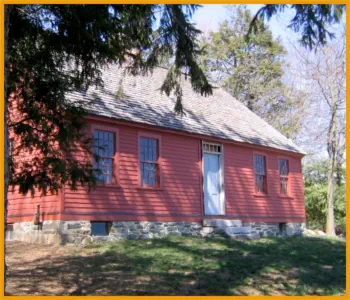



Orange Historical Society


Orange, Connecticut
History
Where Did They Shop?.....
When
the
early
settlers
came
to
Milford
in
1639,
they
didn’t
bring
much
food
with
them
on
those
tiny
ships
and
no
anticipation
of
finding
shops
as
in
England
for
sustenance.
But
Peter
Prudden
brought
his
people
from
Herfordshire,
England
aboard
the
ship
Martin
in
1637
with
the
hopes
of
finding
a
paradise,
a
haven
from
the
tyranny
in
England
at
the
time.
Names
like
James
Prudden,
Edmund
Tapp,
the
Buckinghams, William East and others accompanied him but they did not settle in the Milford colony initially.
They
remained
in
Boston
for
a
spell
and
were
urged
to
make
it
their
permanent
home
but
both
John
Davenport
(Davenport
Ave.
in
New
Haven)
and
Prudden
had
other
ideas,
wanting
to
establish
a
colony
of
their
own.
They
went
down
to
the
Quinnipiac
River
area,
Davenport
settling into the New Haven area while Prudden wanted to move west.
Before
the
Prudden
group
settled
Milford,
they
stayed
in
New
Haven
in
one
of
the
nine
squares
on
the
western
corner
of
what
is
now
the
New
Haven
Green.
There
they
planted
crops
and
built
houses.
At
one
point,
Rev.
Prudden
went
to
the
town
of
Wethersfield
to
preach
and
being
a
forceful
man,
who
won
the
devotion
of
his
listeners,
agreed
to
seek
new
lands
for
a
settlement
and
by
February
12,
1639,
a
small
group
of
men,
Alexander
Bryan
being
one
of
them,
purchased
land
from
the
sachem
of
the
Paugussetts,
Ansantawae.
You
have
read
this
part before, folks.
The
real
story
of
the
relationship
between
the
Paugussetts
and
the
colonist
is
a
bit
of
an
exaggeration
as
there
were
problems
and
Rev.
Erastus
Scranton,
who
is
given
credit
for
part
of
our
Green,
writes
in
his
1830
statistical
account
of
various
and
sundry
altercations
within
the two groups.
The
stockade,
which
helps
to
solidify
the
two,
only
came
in
1700
when
the
Mohawks,
hidden
in
the
swamp,
descended
on
the
Paugussetts.
stealing
their
winter
supplies,
their
“store”
if
you
will.
There
is
no
evidence
that
these
colonists
ever
suffered
for
the
want
of
food
nor
water, as many springs were located within the town.
The
resources
of
the
land
were
many
in
the
trees
alone,
providing
for
food,
shelter
and
domestic
use.
Not
long
after
the
settlement
there
emerged
manufacturing
with
11
stores
of
groceries
and
dry
goods
popping
up
throughout
the
colony
in
addition
to
the
leather
tanners,
blacksmiths, wheelwrights, hatters, chandlers * and coopers.**
They
had
a
store
in
North
Milford
too
as
this
colony
was
beginning
to
burst
at
the
seams
by
1750.
John
Bryan
opened
a
store
on
the
west
side
of
the
Green,
our
first
store
but
in
1838,
he
lost
it
through
bankruptcy
and
it
was
ultimately
auctioned
to
Samuel
Johnson,
who
in
1841
sold it to the North Milford Ecclesiastical Society, the Congregational Church of today.
The
store
was
located
in
the
area,
or
street
if
you
will,
in
front
of
the
parson’s
house
today.
The
road
west
went
through
the
town
green
running on the south side of the shop. Of course, Meeting House Lane does not cut through the Green but runs north of it.
The
2nd
store
was
that
of
Dennis
Stone,
just
across
the
street
on
the
corner
of
what
is
now
Tyler
City
Road
and
Orange
Center
or
North
Main
as
it
was
then.
He
divided
his
Greek
Revival
house
into
two
halves
with
the
left
being
the
general
store.
With
the
continuation
of
blacksmiths,
shoemakers
and
the
like,
Mr.
Stone
carried
household
items
and
foodstuff
that
could
be
preserved
in
barrels.
“See”
the
two
doors at the Stone-Otis House? The one on the left is a barrel door, wide enough to roll in the barrels of dry goods and the like.
Now
to
the
3rd
and
last
general
store
in
our
town,
the
Scobie
store,
still
standing,
is
opposite
the
small
shopping
center
on
Orange
Center
Road.
By
1880,
it
was
a
flurry
of
activity
with
the
post
office
located
there
and
are
you
ready
for
this?....the
first
telegraph
station
with
three customers connected to Scobie using the dots and dashes of Morse code.
By
1895,
the
first
telephone
system
was
inaugurated
as
a
single,
private
and
party
line
from
the
Scobie
store,
to
3
customers
then
4
and
by
1908
when
the
number
hit
44,
the
system
became
the
Southern
New
England
Telephone
Company.
For
many
years
the
Scobie
store
served
not
only
the
town
but
those
folks
who
rode
the
train
from
New
Haven
to
Derby
and
back,
as
the
train
station
was
just
across
the
street. Can you imagine the different visitors that shopped at this general store, the last, historic, commercial building in our town?
We
will
never
know
a
who’s
who
for
Elbert,
George
and
William
Scobie’s
customers
and
only
by
history
of
other
general
stores
can
we
assume
what
he
sold
but
suffice
it
to
say,
the
Scobies
made
their
mark
in
Orange
and
through
continued
ownership
as
a
residence,
it
stands
as
a
reminder
of
how
the
town
grew,
step
by
step,
landing
into
2022.
Elbert,
like
other
entrepreneurs
sought
to
offer
copies
of
parts
of
the
town
through
postcards,
printed
in
Germany.
These
postcards
are
collectors’
items
and
most
cannot
be
found
any
longer
in
the
open market as collectors have held onto them and their value has soared.
Not only do we have the store as a reminder of its history but the postcards as well…thanks Elbert!
*chandler made candles.
** cooper make barrels












Bryan Andrew







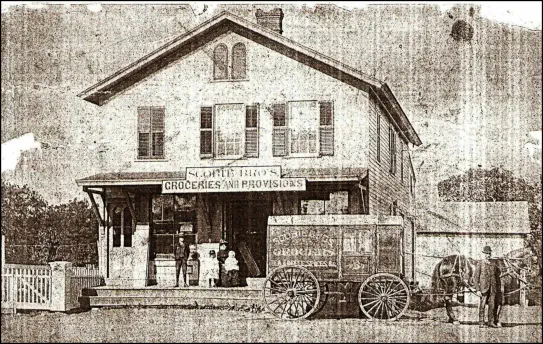




Orange Historical Society
Orange, Connecticut








Bryan Andrew





Where Did They Shop?
When
the
early
settlers
came
to
Milford
in
1639,
they
didn’t
bring
much
food
with
them
on
those
tiny
ships
and
no
anticipation
of
finding
shops
as
in
England
for
sustenance.
But
Peter
Prudden
brought
his
people
from
Herfordshire,
England
aboard
the
ship
Martin
in
1637
with
the
hopes
of
finding
a
paradise,
a
haven
from
the
tyranny
in
England
at
the
time.
Names
like
James
Prudden,
Edmund
Tapp,
the
Buckinghams,
William
East
and
others
accompanied
him
but
they
did
not
settle
in
the Milford colony initially.
They
remained
in
Boston
for
a
spell
and
were
urged
to
make
it
their
permanent
home
but
both
John
Davenport
(Davenport
Ave.
in
New
Haven)
and
Prudden
had
other
ideas,
wanting
to
establish
a
colony
of
their
own.
They
went
down
to
the
Quinnipiac
River
area,
Davenport
settling
into
the
New
Haven
area
while
Prudden
wanted
to
move
west.
Before
the
Prudden
group
settled
Milford,
they
stayed
in
New
Haven
in
one
of
the
nine
squares
on
the
western
corner
of
what
is
now
the
New
Haven
Green.
There
they
planted
crops
and
built
houses.
At
one
point,
Rev.
Prudden
went
to
the
town
of
Wethersfield
to
preach
and
being
a
forceful
man,
who
won
the
devotion
of
his
listeners,
agreed
to
seek
new
lands
for
a
settlement
and
by
February
12,
1639,
a
small
group
of
men,
Alexander
Bryan
being
one
of
them,
purchased
land
from
the
sachem
of
the
Paugussetts,
Ansantawae.
You
have
read
this
part
before, folks.
The
real
story
of
the
relationship
between
the
Paugussetts
and
the
colonist
is
a
bit
of
an
exaggeration
as
there
were
problems
and
Rev.
Erastus
Scranton,
who
is
given
credit
for
part
of
our
Green,
writes
in
his
1830
statistical
account
of
various
and
sundry
altercations
within
the
two
groups.
The
stockade,
which
helps
to
solidify
the
two,
only
came
in
1700
when
the
Mohawks,
hidden
in
the
swamp,
descended
on
the
Paugussetts.
stealing
their
winter
supplies,
their
“store”
if
you
will.
There
is
no
evidence
that
these
colonists
ever
suffered
for
the
want
of
food
nor
water,
as
many
springs
were
located within the town.
The
resources
of
the
land
were
many
in
the
trees
alone,
providing
for
food,
shelter
and
domestic
use.
Not
long
after
the
settlement
there
emerged
manufacturing
with
11
stores
of
groceries
and
dry
goods
popping
up
throughout
the
colony
in
addition
to
the
leather
tanners,
blacksmiths,
wheelwrights, hatters, chandlers * and coopers.**
They
had
a
store
in
North
Milford
too
as
this
colony
was
beginning
to
burst
at
the
seams
by
1750.
John
Bryan
opened
a
store
on
the
west
side
of
the
Green,
our
first
store
but
in
1838,
he
lost
it
through
bankruptcy
and
it
was
ultimately
auctioned
to
Samuel
Johnson,
who
in
1841
sold
it
to
the
North
Milford
Ecclesiastical
Society,
the
Congregational
Church of today.
The
store
was
located
in
the
area,
or
street
if
you
will,
in
front
of
the
parson’s
house
today.
The
road
west
went
through
the
town
green
running
on
the
south
side
of
the
shop.
Of
course,
Meeting
House
Lane
does
not
cut
through
the
Green
but
runs
north
of it.
The
2nd
store
was
that
of
Dennis
Stone,
just
across
the
street
on
the
corner
of
what
is
now
Tyler
City
Road
and
Orange
Center
or
North
Main
as
it
was
then.
He
divided
his
Greek
Revival
house
into
two
halves
with
the
left
being
the
general
store.
With
the
continuation
of
blacksmiths,
shoemakers
and
the
like,
Mr.
Stone
carried
household
items
and
foodstuff
that
could
be
preserved
in
barrels.
“See”
the
two
doors
at
the
Stone-Otis
House?
The
one
on
the
left
is
a
barrel
door,
wide
enough
to
roll
in
the
barrels of dry goods and the like.
Now
to
the
3rd
and
last
general
store
in
our
town,
the
Scobie
store,
still
standing,
is
opposite
the
small
shopping
center
on
Orange
Center
Road.
By
1880,
it
was
a
flurry
of
activity
with
the
post
office
located
there
and
are
you
ready
for
this?....the
first
telegraph
station
with
three
customers
connected
to
Scobie
using the dots and dashes of Morse code.
By
1895,
the
first
telephone
system
was
inaugurated
as
a
single,
private
and
party
line
from
the
Scobie
store,
to
3
customers
then
4
and
by
1908
when
the
number
hit
44,
the
system
became
the
Southern
New
England
Telephone
Company.
For
many
years
the
Scobie
store
served
not
only
the
town
but
those
folks
who
rode
the
train
from
New
Haven
to
Derby
and
back,
as
the
train
station
was
just
across
the
street.
Can
you
imagine
the
different
visitors
that
shopped
at
this
general
store,
the
last,
historic,
commercial building in our town?
We
will
never
know
a
who’s
who
for
Elbert,
George
and
William
Scobie’s
customers
and
only
by
history
of
other
general
stores
can
we
assume
what
he
sold
but
suffice
it
to
say,
the
Scobies
made
their
mark
in
Orange
and
through
continued
ownership
as
a
residence,
it
stands
as
a
reminder
of
how
the
town
grew,
step
by
step,
landing
into
2022.
Elbert,
like
other
entrepreneurs
sought
to
offer
copies
of
parts
of
the
town
through
postcards,
printed
in
Germany.
These
postcards
are
collectors’
items
and
most
cannot
be
found
any
longer
in
the
open
market
as
collectors
have
held
onto
them
and
their
value
has
soared.
Not
only
do
we
have
the
store
as
a
reminder
of
its
history but the postcards as well…thanks Elbert!
*chandler made candles.
** cooper make barrels

History

